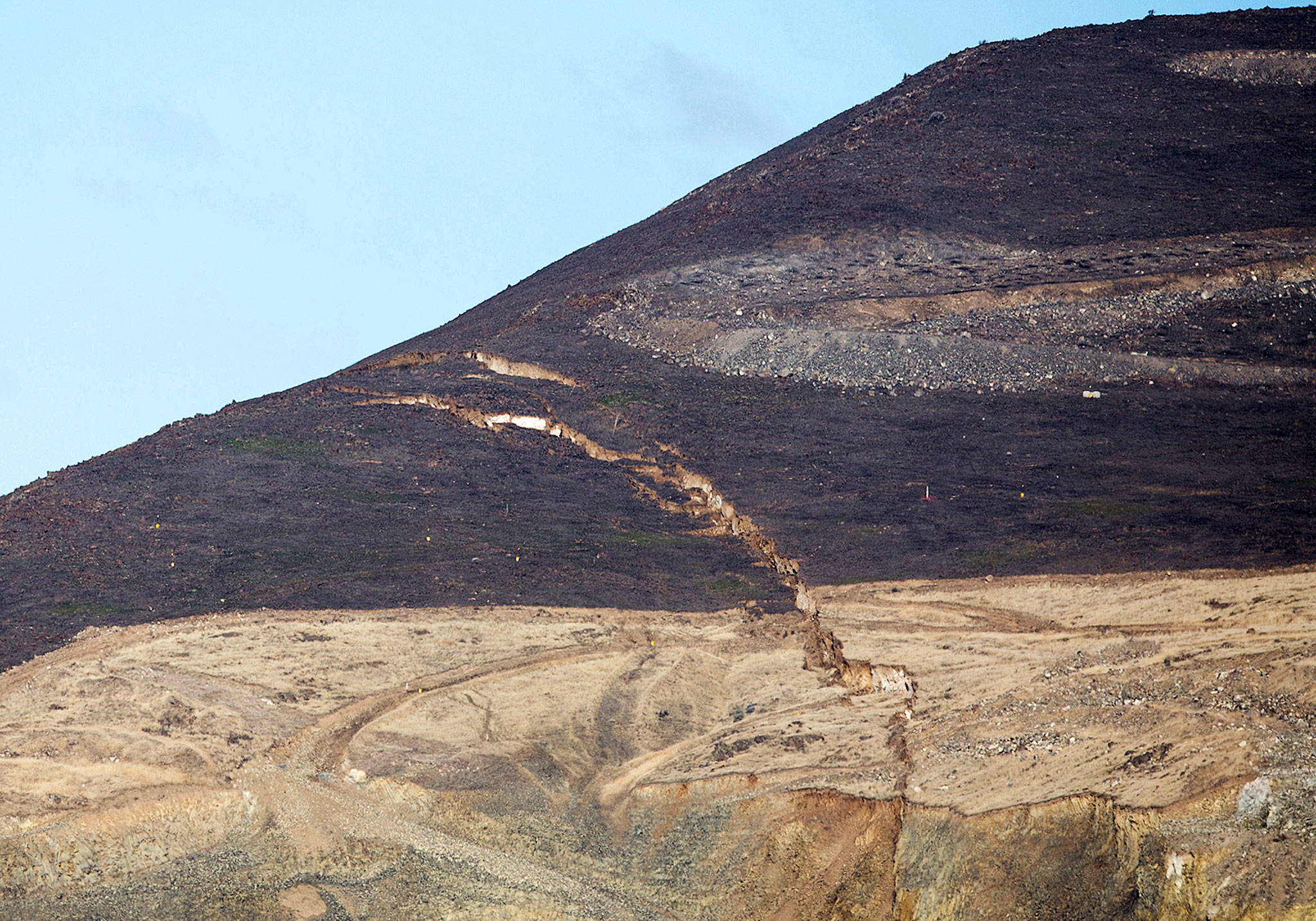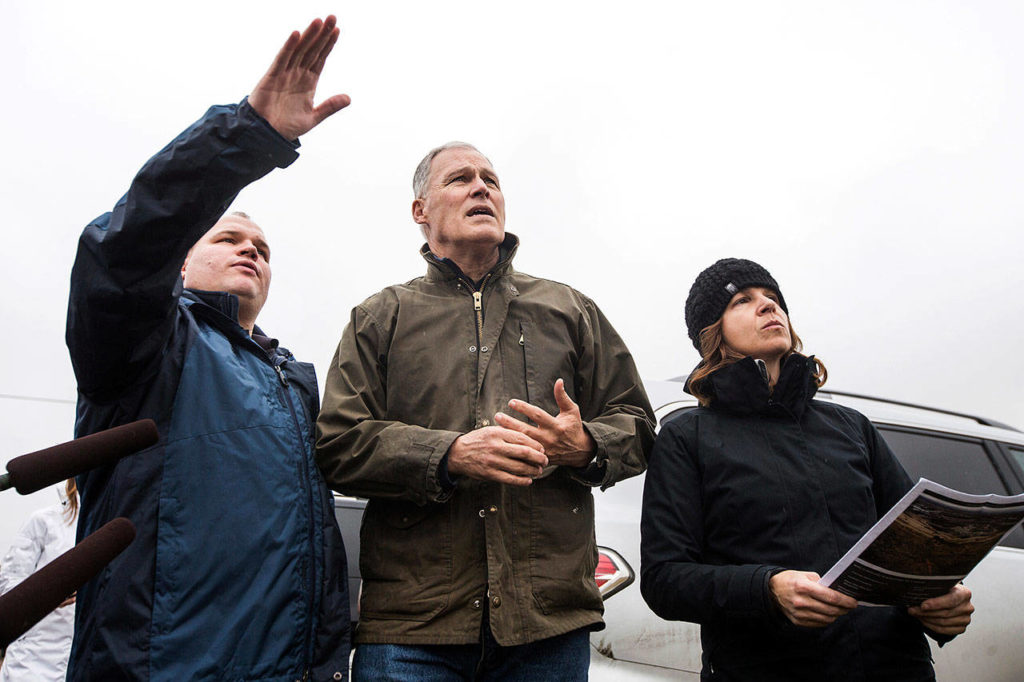By Tammy Ayer / Yakima Herald-Republic
YAKIMA — While authorities reiterated Sunday that no one can predict exactly when the Rattlesnake Ridge landslide will occur, they’ve pushed the estimated date to late January or early February.
Meanwhile, Gov. Jay Inslee, who toured the site just south of here Sunday, said an independent geologist will join the team already monitoring the progress of the roughly 20-acre, 200-foot-deep mass of basalt that continues to slide down the south side of the ridge at about 1.5 feet a week, potentially threatening I-82 and the Yakima River.
“This is a significant risk that we have significant concerns about,” Inslee said. “We are continuing to determine whether there should be additional monitoring or additional analysis … and in the next several days we will probably be engaging a third-party independent consultant that would work for the state of Washington for the multiple agencies involved.”
He hopes to fill that role within a week.
“I don’t sense a gap in our analytical ability. We have multiple geologists looking at this … every day,” he said. “But we want to give the public more confidence that there is someone who is outside state agencies who is also not hired by the quarry owner so that we know that they’re totally independent.”
During his visit, Inslee joined about 40 officials with local and state agencies and the Yakama Nation who heard from Dave Norman, state geologist for the Department of Natural Resources, in a closed briefing held at the Yakima Air Terminal.
Authorities, who had previously estimated a slide could potentially occur in mid-January, extended the estimate to later in the month or early February.
After the nearly hour-and-a-half briefing, Inslee and others took I-82 to drive by the south side of the ridge before stopping along Lateral A Road near its intersection with U.S. Highway 97.
Though thick morning fog had thinned somewhat, the top of the ridge was still enveloped as Jeff Emmons, emergency management director for the Yakima Valley Office of Emergency Management, pointed toward the Anderson Quarry — shuttered since October — and the harder to see growing fissure above it.
The hillside has been sliding since at least October when authorities began monitoring cracks that had opened atop the western slope of Rattlesnake Ridge. At that time, the landslide was moving at less than an inch per day. As of Friday, that had increased to 2.5 inches.
Authorities have spoken with 67 residents potentially affected by the landslide, said Horace Ward, senior emergency manager with the Yakima Valley Office of Emergency Management.
That number has been fluid because some residents are on vacation and others were difficult to reach due to unusual work hours, Ward said Sunday. But it’s believed everyone potentially affected has now been contacted, he added.
Those residents, who lived in a small community on Thorp Road, are under an evacuation order as an estimated 4 million cubic yards of rocks and dirt continues to slide south.
“They’re being offered storage units for free for the next three months,” said Ward, adding all agreed to take free, five-week paid hotel stays.
Other agencies are working on longer-term options, he noted, adding that the shelter offered to those evacuating has closed.
No significant movement occurred overnight, authorities said Sunday morning.
“To my knowledge, nothing of large scale has happened overnight … there’s been no significant movement,” Ward said.
And though Inslee was interested in a closer look near the now-closed Thorp Road and concrete-filled shipping containers placed along it to stop falling rocks, he stressed safety was more important.
“I did not go to the scene because we’re encouraging people to please avoid this area,” Inslee said. “There’s a lot of work going on in this area. … Don’t bother folks who are doing geological work up there.”
Norman, the state geologist, noted that while “one or two rocks” have rolled down the hill so far, “There is rockfall occurring in the quarry itself on a daily basis.”
Asked about the possibility of the slide reaching the Yakima River, Inslee repeated what members of the emergency management team have been saying.
“The geologists have indicated that that is a very low probability with the information we have,” Inslee said, “but we have to make sure we monitor this on an hourly basis because if something changes, we want to be able to respond on a minute-by-minute response plan.”
Flooding is a worst-case scenario, Inslee said.
“There is an evaluation of potential flooding risk. … It is not predicted for this to happen, but if there was a flooding event in Union Gap, there are already emergency preparations to deal with any flooding event,” he said.
“We talked to the Union Gap Police Department and emergency response folks; they already have a plan for that.”
Officials are monitoring the landslide around the clock in person and using an array of monitoring devices that include GPS monitoring stations, seismometers, total station receivers and terrestrial LIDAR — light detection and ranging. That’s a remote sensing method that uses lasers to measure distances, according to the National Ocean Service, a part of National Oceanic and Atmospheric Administration.
Norman said rainfall isn’t driving the landslide but a large snowfall followed by a quick melt could speed it up and plans are all being developed around worst-case scenarios.
“As this event unfolds, we get more evidence and more information and we’re able to get better ideas of what’s going to happen,” he added.
Plans include two potential detours should the landslide close I-82. One detour to route traffic to U.S. Highway 97, a second would send traffic from the Tri-Cities past Mattawa to Interstate 90 near Vantage.
Some residents have suggested using controlled blasting to trigger the landslide, but Inslee said that is not an option.
Explosives “have been considered but really not seen as a viable option. The state does not have enough confidence that that wouldn’t create a larger problem,” he said.
In the case of the Rattlesnake Ridge landslide, caution is paramount, Inslee stressed.
“We are treating this slide with extreme caution, with extreme sensitivity and the ‘nth’ degree of evaluation,” he said. “And we’ve got to do that because human life is an issue here. We have to take this with extreme caution.”
Talk to us
> Give us your news tips.
> Send us a letter to the editor.
> More Herald contact information.


























